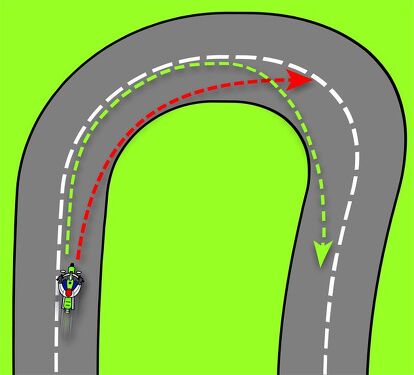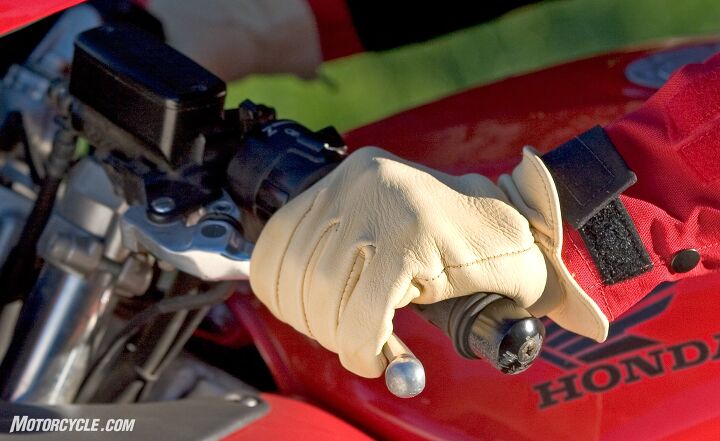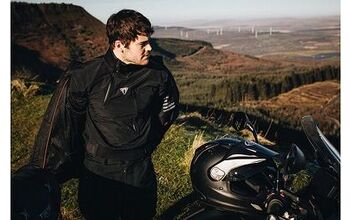8 Essential Motorcycle Riding Skills

Riding motorcycles is a life-long learning process
Riding a motorcycle is a challenging activity. For many of us, that is part of the attraction. However, the steepness of the learning curve can be daunting to new riders – or even returning riders who want to freshen-up their skills. While we’re always going to suggest that beginning and returning riders take a motorcycle safety course, there are many skills that riders can practice on their own to make their ride safer and more enjoyable.
The list below features skills that we, as experienced riders, feel are essential to proficient motorcycle riding. You’ll notice how we start with the most basic of basic skills and move on to more advanced ones. Since mastery of the techniques required to operate a motorcycle is a cumulative process, don’t skip over the first few items because they sound so simple. They’re not. Self-aware riders will admit that every ride involves a bit of polishing of each of these techniques as they are encountered.
We MOrons feel that riding motorcycles is a life-long learning process. That’s why we keep attending track schools to sharpen our skills. Read on to find out where your interests lie.
Clutch Control
How many times have you seen a rider lurch away from a start? Was it the lack of an important skill or just inattention? Only they can answer that question, but without mastery of the clutch release, riding will be much more difficult than it needs to be. The building block of all clutch skills is the concept of the friction zone, the section of the clutch lever travel where the clutch transitions from being disengaged to being engaged. Manipulating the friction zone will not only deliver smooth starts, but also enable easy low-speed maneuvers (like U-turns).
Throttle Control
We’ve all seen those hilarious YouTube videos where a first-time rider is put on a bike and proceeds to dump the clutch, ending up flying across a parking lot and crashing into something. Yucks all around. However, those videos illustrate two major mistakes on the part of the person teaching the newbie how to ride. The first was not teaching about the friction zone as mentioned above. The second, the one that leads to all the disaster, was not making sure that the new rider had their throttle hand in the wrist-down position. With the wrist in the up position, an abrupt throttle input can lead to what is known as whiskey throttle, a situation where the rider is pitched backwards by an inadvertent throttle input, causing their wrist to crank on even more throttle. The wrist-down position also forces the rider to close the throttle completely when reaching for the front brake lever.
All of this must be considered before any actual riding of a motorcycle occurs. The real throttle skills are delivering smooth inputs for acceleration, rolling on the throttle through a turn, and matching engine speed on a downshift. If any of these sound alien to you, get thee to a motorcycle safety class!
Basic Braking Skills
Poor braking skills are ranked very high in motorcycle accident statistics. In a braking-induced crash, the rider’s technique was typically characterized by underutilizing the front brake and overusing the rear – often to the point of lockup. The other common scenario is the rider who grabs an abrupt handful and locks the front brake. Although the inclusion of ABS in most newer motorcycles has taken the fear of locking the front brake away from many riders (and prevents the locking of the rear!), many riders don’t have a firm grasp of the dynamics involved in motorcycle braking.
Since motorcycles have a relatively high center of gravity, as the rider brakes, the bike’s center-of-gravity (CG) shifts forward, pressing the front tire into the pavement and making more braking power available. So, a skilled rider is building pressure throughout a hard braking maneuver. If a rider tries to immediately apply maximum braking power to the front brake before the weight has shifted, the wheel will lock and skid – or the ABS will trigger.
Meanwhile, out back, the rear brake’s ability to help slow the motorcycle is diminishing as the CG moves forward. To complicate matters, the type of bike also affects the amount of rear braking power available to the rider. Adventure bikes, sportbikes, and standards have higher CG leading to lower rear braking power, while cruisers and touring bikes, which carry more weight on the rear of the motorcycle, have more rear traction available when braking.
If any of this is news to you, go take a motorcycle safety course.
Countersteering
Countersteering is how we make motorcycles turn. The long and short of countersteering is that you turn the handlebar in the opposite direction of the way you want to turn. Want to go right? Turn the handlebar to the left. This counterintuitive turning process illustrates why it is so important to learn countersteering. Simply put, riders who don’t completely grasp countersteering – down to the muscle-memory level – have been shown in accident studies to actually turn their motorcycles towards the very thing they are trying to avoid hitting.
Every turn, every crash avoidance maneuver is built, at least in part, on countersteering. Swerving around an object in the road? Countersteering to change course followed by a pause to clear the object and completed with a second countersteer in the opposite direction to return to the direction of travel.
If you have any doubts about countersteering, please take a motorcycle safety course.
Smooth Downshifting
Remember a few items ago when we were considering throttle and clutch control? Well, now we’re going to combine them. Imagine that you’re entering a corner and that, in order to have your engine in the correct rpm range, you need to downshift. The last thing you want to do at the corner entry is upset the chassis with a botched shift!
The secret to a smooth downshift is maddeningly simple. All you have to do is exactly match the increase in engine speed required by the lower gear. In reality, it’s not so simple. That’s why the clutch release is so important. Dump the clutch with mismatched rpm and the chassis bobbles. Or worse, the rear tire can skip. A tactful clutch release smooths over those differences in engine speed.
Motorcycle Downshifting Techniques
Practice, practice, practice!
Situational Awareness
News flash: Motorcycles are more vulnerable that most other vehicles on the road. Additionally, because of their small size, they are virtually invisible to other road users. Even if we aren’t invisible, we need to ride as if we are. The consequences of a crash are too great.
Situational awareness means the rider is constantly scanning the road ahead, looking for potential hazards. Those dangers can be other road users, objects/animals/people that could enter the roadway unexpectedly, and the road itself. Riding a motorcycle requires constant vigilance. However, once a potential risk is identified, the process continues with anticipating what could happen and preparing a plan of action for how to avoid the risk. However, you’re not done there. You’re still scanning further ahead and repeating the process! Over and over and over.
Line Selection
When most riders think of line selection, they think of choosing the best path through a corner or a series of turns. However, there’s more to line selection than that. There are many kinds of lines through corners, and they each have their place in your riding tool kit. Perhaps the most familiar is the classic racing line which starts out wide at the entrance, cuts in tight at the corner’s apex, and drifts wide again at the exit. This is fine for a constant-radius corner, but how many turns are that simple?
Late apexing a corner holds the bike wide through the bulk of the corner, only slicing in towards the apex at the end of the turn. This technique is particularly helpful in decreasing-radius corners. Finally, early-apexing corners is often considered to be a mistake because it sends the rider wider at the exit of a corner where they could potentially run out of lane. However, this line has its place in a corner that starts off as one type of turn, widens slightly in the middle, and then returns to the previous radius. In this case, the rider double-apexes the corner by early-apexing the initial radius, drifting wide, and then diving in for a late apex at the end of the corner.
Still, choosing the right line isn’t all about cornering. Your line both in corners and in the straight up and down also includes your path around problems, like potholes, painted lines, or manhole covers, you may encounter along your ride.
If any of this theory interests you, a track riding school should be in your future.
Advanced Braking Techniques
When you first took a motorcycle safety class as a new rider, you were probably instructed to wrap all four fingers around the throttle and only apply the front brake with all four fingers when the throttle was closed. This is totally correct for a new rider in a parking lot, learning how to control the throttle and brake. You learn correct technique by separating the application of throttle from braking – to make the process less complicated and make sure you become proficient at it. However, once you’ve been out on the road for a while, you notice how difficult it is to cover the front brake with all four fingers when your situational awareness says you may need your brakes soon. At this point in the learning curve, many riders naturally start to cover the front brake with two fingers. This allows them to shorten their reaction time should the need for maximum braking arises.
Shortening reaction time isn’t the only benefit of having two fingers always on the brake lever. Advanced braking techniques include applying the brake as you roll off the throttle. You can also blip the throttle for downshifts while maintaining consistent brake pressure – though it takes a lot of practice. This also makes it possible for you to trail the brakes all the way to the apex of a corner to assist in getting your bike to turn in quickly thanks to the compressed fork and enlarged front contact patch.
Advanced braking doesn’t just take place on the front brake either. Many riders modulate their bike’s acceleration out of a corner with the rear brake. A street-riding example would be when accelerating after a corner’s apex and having the corner go on longer than expected. Rather than rolling off the throttle and possibly unsettling the chassis, hold the throttle constant and use the rear brake to attenuate the speed slightly.
For riders who find the intricacies of braking fascinating, go take some track schools. You’ll be glad you did.

Like most of the best happenings in his life, Evans stumbled into his motojournalism career. While on his way to a planned life in academia, he applied for a job at a motorcycle magazine, thinking he’d get the opportunity to write some freelance articles. Instead, he was offered a full-time job in which he discovered he could actually get paid to ride other people’s motorcycles – and he’s never looked back. Over the 25 years he’s been in the motorcycle industry, Evans has written two books, 101 Sportbike Performance Projects and How to Modify Your Metric Cruiser, and has ridden just about every production motorcycle manufactured. Evans has a deep love of motorcycles and believes they are a force for good in the world.
More by Evans Brasfield













































Comments
Join the conversation
Evans gets points for another great article, but loses points for finding another chance to use that close-up photo of his face in the helmet j/k.
Seriously, keep the good content coming
Well, maybe the most important rider bike control skill is this: riding always with fingers covering clutch and brake levers and still controlling throttle twist of the wrist. Next thinking about how to keep the bike moving along on the two tires; think this, as moving along if the upper part of bike begins to lean more than you planned; as a result, you must steer the front wheel in direction of bike leaning; it follows, to raise the upper part of bike, stop or slow lean, and move the front tire back under upper part of bike while moving slong. And last, learn to shift gears up- and down-shifts using minimal use of clutch and more engine speed blips and dips to move transmission gear dogs between the various mating gear slots at slow and fast road speeds. Also, keeps eyes up and at night scan side to side because eyes side vision is more sensitive at night or low light riding conditions.